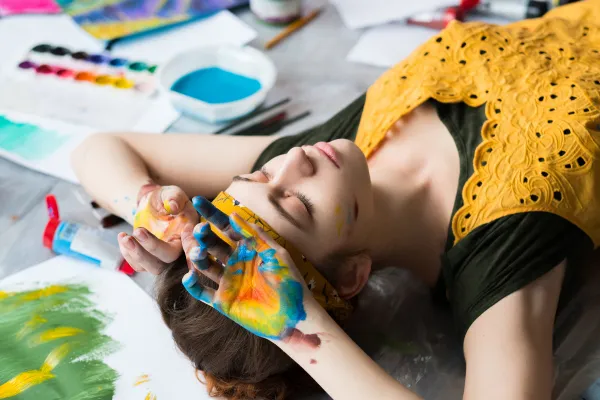

The Therapeutic Power of Art for Anger Management
Anger is a natural human emotion, but when left unchecked, it can lead to stress, strained relationships, and even health issues. Managing anger in a healthy way is important for overall health. And one surprisingly effective tool for this is art. Creative expression, whether through painting, drawing, sculpting, or other artistic activities, has been shown to help people process emotions, release tension, and find inner peace. But how exactly does art help manage anger?
Before we look at how art helps regulate emotions, let’s look at the damaging effects of anger.
How Does Anger Affect Us?
Uncontrolled anger can have serious consequences. It can affect both our mental and physical health.
When anger is left unchecked, it can lead to chronic stress, anxiety, and even depression.
The constant release of stress hormones, such as cortisol and adrenaline, puts immense strain on the body, increasing the risk of high blood pressure, heart disease, and weakened immune function.
Uncontrolled anger can cloud judgment, leading to impulsive decisions and destructive behavior that can harm personal and professional relationships.
It can create a cycle of negativity, making it difficult for us to maintain inner peace and emotional stability.
It can damage relationships and social interactions. Outbursts or prolonged resentment can push away loved ones, creating isolation and loneliness.
In workplaces, uncontrolled anger can lead to conflicts, job loss, or a toxic work environment, hindering career growth.
Anger can also fuel aggression, leading to verbal or even physical altercations that have legal or societal consequences.
Anger may escalate into patterns of violence or abuse.
Learning to manage anger is essential for maintaining emotional balance, healthy relationships, and overall health. That’s where art therapy comes in.
The Science Behind Art and Emotional Regulation
Art therapy has been widely studied for its psychological benefits, particularly in managing stress, anxiety, and anger. Research suggests that engaging in creative activities can have a profound impact on the brain and emotional health.
1. Art Engages the Brain’s Reward System
When you create art, your brain releases dopamine, a neurotransmitter associated with pleasure and motivation. This not only lifts your mood but also helps counteract the negative emotions that come with anger.
2. Creative Activities Reduce Stress Hormones
A study shows that people who are engaged in artistic activities significantly reduce cortisol levels (the body's primary stress hormone). Lower cortisol levels mean a calmer nervous system, which helps in managing anger more effectively.
3. Art Provides a Safe Emotional Outlet
Unlike verbal communication, which can sometimes escalate conflict, art provides a non-verbal way to express emotions. Creating something visual allows individuals to channel their frustrations into colors, shapes, and forms rather than words or actions that could harm relationships.
4. Engaging in Art Promotes Mindfulness
Mindfulness is the practice of being present in the moment without judgment. Activities like drawing or painting require focus and attention, naturally bringing individuals into a state of mindfulness. This heightened awareness can help break the cycle of reactive anger by creating a sense of control and calmness.
Practical Ways to Use Art for Anger Management
You don’t need to be a professional artist to benefit from creative expression. Here are some simple and effective ways to use art as a tool for managing anger:
1. Doodle Your Frustrations Away
When you feel anger bubbling up, grab a pen and start doodling. This simple act can serve as an immediate distraction, helping you shift your focus and reduce emotional intensity.
2. Try Abstract Painting
Expressing emotions through abstract art can be incredibly therapeutic. Use bold colors, heavy brushstrokes, or different textures to channel your emotions onto the canvas. The act of applying paint can serve as a physical release of pent-up tension.
3. Create an Anger Journal
Instead of a traditional journal, use colors and shapes to represent your feelings. Assign different colors to different emotions and create visual entries that depict your emotional state.
4. Sculpt or Mold Clay
Working with clay or Play-Doh can be a great way to release frustration. The physical act of kneading and shaping the material provides a satisfying outlet for built-up anger.
5. Mandala Coloring for Relaxation
Coloring intricate patterns, like mandalas, has been proven to have a calming effect. The repetitive motion and focus required can help redirect energy away from anger and into a meditative state.
6. Music and Art Fusion
Listening to music while painting or drawing can enhance the therapeutic benefits. Upbeat music can energize you, while soft, soothing tunes can help calm your mind and body.
The benefits of using art to manage anger extend beyond the immediate emotional release. Over time, engaging in creative activities helps build emotional resilience, allowing individuals to better handle stress and frustration in everyday life. Art builds self-awareness, promotes relaxation, and strengthens problem-solving skills. Qualities that contribute to a more balanced and peaceful state of mind.
So, the next time you feel anger creeping in, reach for a paintbrush, a sketchpad, or even a lump of clay. Let your creativity guide you toward calmness, clarity, and emotional healing. You don’t have to create a masterpiece; just the act of making art is enough to bring relief. Give it a try and experience the transformative power of creativity in managing anger!
ABOUT US

Jeanne Prinzivalli
Therapist + Coach
I help ambitious, anxious women learn how to trust and put themselves first, so they can stop burning themselves out trying to meet other people's expectations.
SELF CARE CONTINUUM
CLIENT LINKS
LET'S CONNECT
Let’s get you started on relief from self-sabotaging patterns so you can move forward with your life and career passions.
Self Care Continuum Copyright © 2023.




